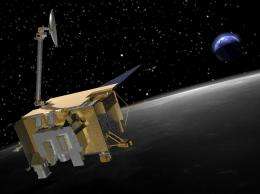Cosmic rays alter chemistry of lunar ice

Space scientists from the University of New Hampshire and multi-institutional colleagues report they have quantified levels of radiation on the moon's surface from galactic cosmic ray (GCR) bombardment that over time causes chemical changes in water ice and can create complex carbon chains similar to those that help form the foundations of biological structures. In addition, the radiation process causes the lunar soil, or regolith, to darken over time, which is important in understanding the geologic history of the moon.
The scientists present their findings in a paper published online in the American Geophysical Union's Journal of Geophysical Research (JGR)-Planets. The paper, titled "Lunar Radiation Environment and Space Weathering from the Cosmic Ray Telescope for the Effects of Radiation (CRaTER)," is based on measurements made by the CRaTER instrument onboard NASA's Lunar Reconnaissance Orbiter (LRO) mission. The paper's lead author is Nathan Schwadron, an associate professor of physics at the UNH Space Science Center within the Institute for the Study of Earth, Oceans, and Space (EOS). Co-author Harlan Spence is the director of EOS and lead scientist for the CRaTER instrument.
The telescope provides the fundamental measurements needed to test our understanding of the lunar radiation environment and shows that "space weathering" of the lunar surface by energetic radiation is an important agent for chemical alteration. CRaTER measures material interactions of GCRs and solar energetic particles (SEPs), both of which present formidable hazards for human exploration and spacecraft operations. CRaTER characterizes the global lunar radiation environment and its biological impacts by measuring radiation behind a "human tissue-equivalent" plastic.
Serendipitously, the LRO mission made measurements during a period when GCR fluxes remained at the highest levels ever observed in the space age due to the sun's abnormally extended quiet cycle. During this quiescent period, the diminished power, pressure, flux and magnetic flux of the solar wind allowed GCRs and SEPs to more readily interact with objects they encountered – particularly bodies such as our moon, which has no atmosphere to shield the blow.
"This has provided us with a unique opportunity because we've never made these types of measurements before over an extended period of time, which means we've never been able to validate our models," notes Schwadron. "Now we can put this whole modeling field on more solid footing and project GCR dose rates from the present period back through time when different interplanetary conditions prevailed." This projection will provide a clearer picture of the effects of GCRs on airless bodies through the history of the solar system.
Moreover, CRaTER's recent findings also provide further insight into radiation as a double-edge sword. That is, while cosmic radiation does pose risks to astronauts and even spacecraft, it may have been a fundamental agent of change on celestial bodies by irradiating water ice and causing chemical alterations. Specifically, the process releases oxygen atoms from water ice, which are then free to bind with carbon to form large molecules that are "prebiotic" organic molecules.
In addition to being able to accurately gauge the radiation environment of the past, the now more robust models can also be used more effectively to predict potential radiation hazards spawned by GCRs and SEPs.
Says Schwadron, "Our validated models will be able to answer the question of how hazardous the space environment is and could be during these high-energy radiation events, and the ability to do this is absolutely necessary for any manned space exploration beyond low-Earth orbit."
Indeed, current models were in agreement with radiation dose rates measured by CRaTER, which together demonstrates the accuracy of the Earth-Moon-Mars Radiation Environment Module (EMMREM) being developed at UNH. EMMREM integrates a variety of models describing radiation effects in the Earth-moon-Mars and interplanetary space environments and has now been validated to show its suitability for real-time space weather prediction.
Provided by University of New Hampshire


















